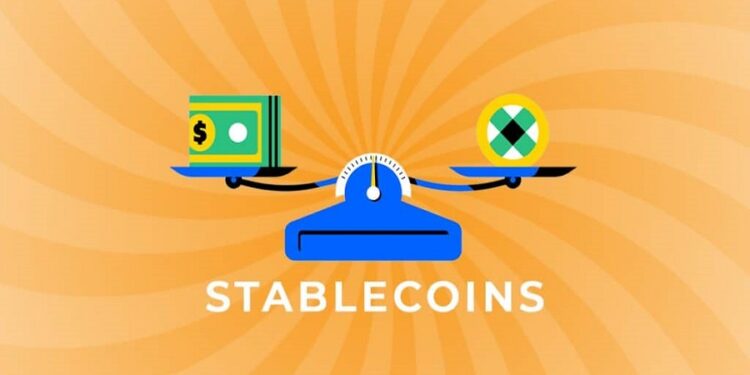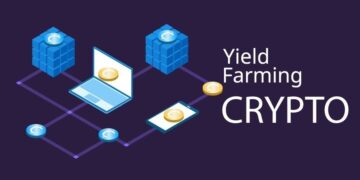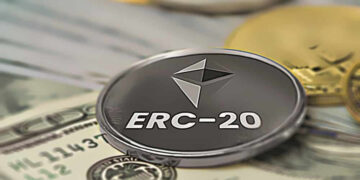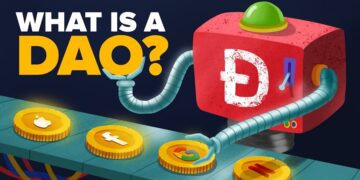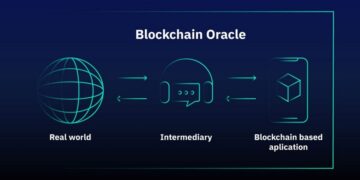Table of Contents
ToggleWhat Are Stablecoins?
Stablecoins are a form of cryptocurrency whose value is linked to that of other currencies, commodities, or financial instruments. The primary objective of stablecoins is to provide a potential remedy to the high volatility plaguing the most widely traded cryptocurrencies, such as Bitcoin (BTC), rendering them less conducive to standard transactions.
Key takeaways
Stablecoins constitute a subset of digital currencies that endeavor to stabilize their market worth by associating them with an external benchmark.
As a means of facilitating transactions, stablecoins are superior to cryptocurrencies with higher volatility.
Stablecoins have the potential to be anchored to a specific currency, such as the U.S. dollar, or linked to the market value of a commodity, such as gold.
Stablecoins seek a stable price by using reserve assets as collateral or implementing algorithmic formulas to regulate the supply.
Regulators closely monitor stablecoins as the market has grown to $153 billion, with concerns over the potential impact on the broader financial system.

What is the reason why stablecoins have become extremely well-known?
The most popular currency, stablecoin Tether, had a market value of around AU$90 billion in August 2021. It is the fifth largest cryptocurrency. In the same vein, having the ninth highest market value, USD Coin has an estimated market value of AU$37 billion. It plays a significant part in the cryptocurrency economy and has numerous advantages over fiat and other cryptocurrencies.Fiat currency isn’t native to crypto
Fiat currency doesn’t have crypto-native and can’t be used to transfer funds over blockchains or utilized in DeFi. The Australian Dollar is indeed stuck in banks that centralized institutions control. Stablecoins can be used to create Smart Contracts on a DeFi platform.Smart contracts are part of DeFi
Stablecoins are a reliable alternative for investors to use to earn a profit within market DeFi market. In this case, you could put a stablecoin in the DeFi protocol. This then loans your stablecoins to generate a dividend.The trading pair is used for other currencies
If traders frequently change between and within different currencies to make the most of the short-term market opportunities, stablecoins simplify this procedure. Although there is a very small market for those who swap RUNE with DCR immediately, they’re extremely liquid when you use stablecoins. Additionally, some traders opt to invest in stablecoins when they feel they are heading downwards.Family members can receive payment for remittances
In contrast to other remittance systems, such as Western Union can have expensive costs. Stablecoins can be an economical way for those to transfer money to relatives in other countries. Since increasingly increasing cryptocurrency exchanges exist, it is simpler for individuals to swap stablecoins for local currencies or directly use them for transactions.Security from the inflation of local currencies
Many people in the United States fear that the US Dollar will inflate and decrease in value. The Dollar is nonetheless much more secure than most local currencies. In particular, the Venezuelan bolivar has risen so quickly that many Venezuelans could not pay for food since their savings were depleted too quickly. Although many Venezuelans switched to Bitcoin to increase their wealth and even some security from the effects of hyperinflation, stablecoins provide an additional option. Since the majority of Venezuelans can’t gain access to US dollars via an institution in their country, local banks could be a good alternative.A stable unit of account
Since cryptocurrency is an extremely volatile asset, it is greatly beneficial for investors to own an asset with the same value. Additionally, they’re a reliable trading account that appreciates tax time.What is the process behind stablecoins?
Within the realm of stablecoins, three distinct types exist: those backed by real-world reserves, those collateralized with cryptocurrencies, and algorithmic stablecoins. Though they all serve as fiat replacements within the crypto economy, they cannot be used interchangeably as each type functions differently.Real-world reserve backed stablecoins
A reserve-backed stablecoin such as USDC is supported by tangible assets, normally cash in a bank. Signifying that a stablecoin linked to the US dollar can be exchanged for an exact dollar. Therefore, individuals possessing one million USDC stablecoins in their digital wallets can demand payment of one million US dollars transferred to their bank accounts. Tether (USDT) and USD Coin (USDC) are some of the widely recognized reserve-backed stablecoins. Primarily, firms running stablecoins are expected to be trusted to have sustained their stablecoin with complete backing to enable the redemption of stablecoins for legitimate dollars. Most stablecoins are bought and sold via virtual currency exchanges, like Cointree. These kinds of stablecoins maintain their peg via market rewards. If the tag falls below $1 to 80 cents. Merchants exploit the chance to purchase the stablecoin, knowing they could cash it for $1 and earn 20 cents per stablecoin purchased. Similarly, if the price goes beyond $1 to $1.20, holders sell the stablecoin, considering it’s overvalued, giving the trader a 20-cent benefit.Collateralised with crypto
Certain stablecoins are supported by currencies other than government-issued fiats, such as bitcoin, instead of backed by the traditional dollar denomination. Functionally, they operate identically to stablecoins that are supported by reserves.Algorithmic
Algorithmic stablecoins do not rely on physical backing to support their value. Using an algorithmic supply mechanism, they are designed to maintain a stable price relative to a specific fiat currency. For instance, when the price of the stablecoin drops below the targeted rate of $1. The system automatically destroys coins until their value stabilizes at the desired level. Terra’s platform, represented by LUNA, is well-suited for enabling the operation of algorithmic stablecoins…What is the future of stablecoins?
According to a report by the Harvard Business Review, cryptocurrencies are expected to play a significant role in the future financial system, as they offer lower-cost, safe, real-time, and more competitive payments compared to traditional payment methods. Stablecoins, in particular, have the potential to make it cheaper for businesses to accept payments and allow governments to run conditional cash transfer programs. Additionally, they could connect the unbanked or underbanked segments of the population to the financial system. The innovation of stablecoins presents an excellent opportunity for DeFi projects and the unbanked population. Blockchain-based stable currencies will become a crucial component of our financial system in the future.What is Yield Farming? Gain a comprehensive understanding of the terminology associated with Yield Farming
The concept of Yield Farming, prominent Yield Farming platforms, and the associated risks and opportunities are explored in this article,...
Read moreWhat is Initial DEX Offering (IDO crypto)? Does playing IDO really give you a 100% chance of winning?
One may inquire as to why the Initial DEX Offering (IDO) has gained widespread popularity and whether investing in IDO...
Read moreWhat is ERC – 20? Advantages, disadvantages & how to create ERC- 20 network tokens
In this article, we will explore ERC-20 and ERC-20 tokens along with their applications and advantages and disadvantages. For those...
Read moreWhat is Airdrop Crypto? Instructions for making airdrop coins in the Crypto market
What is Airdrop and how many forms of Airdrop Crypto exist? Discover the limitations and effective instructions on how to...
Read moreWhat is DAO? Limitations and Investment Potential of DAO in Crypto
Understanding the terminologies used in the field of cryptocurrency is crucial for individuals involved in Crypto market participation or intending...
Read moreWhat is zkEVM? Classification of groups zkEVM
ZkEVM is an abbreviation for the term "Zero-Knowledge Ethereum Virtual Machine". It is a protocol that enables the execution of...
Read moreWhat is web3 technology? How to invest in Web3 in 2023
The emergence of Web 3.0 following Web 2.0 has brought about increased flexibility and superior interaction capabilities compared to its...
Read moreWhat is move to earn? best move to earn crypto in 2023
In the current GameFi market, it is possible to combine the seemingly unrelated tasks of earning money and improving one's...
Read moreWhat does NFT crypto stand for: Clarifying the Significance of Non-Fungible Tokens (NFTs) through technical examination
Non-fungible token (NFT) art are digital assets stored on a blockchain that depict physical or non-physical items, such as digital...
Read moreWhat are play to earn (P2E) Games? How to earn money with play game crypto?
Play to Earn has emerged as a popular trend in mid-2021, leading to a notable increase in the activity of...
Read moreWhat is an oracle in blockchain? Top blockchain oracle projects 2023
The intended function of blockchain technology was never to operate in isolation from the larger economic ecosystem. Despite the challenges...
Read moreBinance account sign up: What is binance account? how to create binance account?
Numerous cryptocurrencies are supported by Binance and its proficiency in ensuring swift exchange operations between volatile coins and fiat currencies...
Read moreWhat is a defining feature of the Metaverse Crypto? What does the term Metaverse refer to?
We have heard numerous prominent figures, such as Mark Zuckerberg, CEO of Facebook, and Satya Nadella, CEO of Microsoft, expound...
Read moreWhat are AI Tokens? Best AI Coins & Tokens to Invest in
The predicted impact of artificial intelligence (AI) is expected to revolutionize various sectors, including the field of cryptocurrency. The AI...
Read moreWhat are Fan Tokens? How Binance Fan Tokens are Revolutionizing the World of Sports and Entertainment?
The Fan Token is a term that has been shared by the CEO of the cryptocurrency exchange CZ on Twitter,...
Read more

